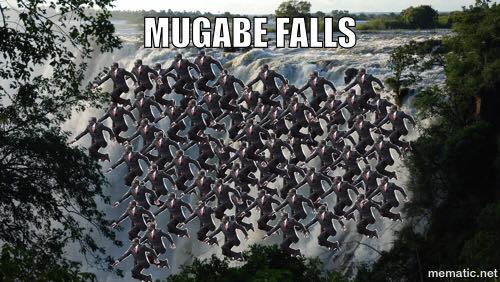If this were a real post, this is where I would tell you how much I absolutely love swatches in Adobe InDesign.
Then, I wold post this image from my InDesign file, which shows the various hues and tints I created:
Lastly, you will post a screenshot of your InDesign layout, showing me your swatch panel. You are pasting this so that I can see that you altered the text color, and so that I know that you did in fact use swatches and that you didn't just use nine different colors!
Thursday, September 24, 2015
Monday, February 23, 2015
Memes
One of the most treasured cultural artifacts Photoshop is helping us create is the "meme". A meme can actually be any cultural phenomenon that is reproduced on a massive scale, but in the age of Photoshop + social media, modern memes tend to revolve around funny images that are made even funnier by changing context, adding text, or both.
As an example, here is an image of the dictator Mugabe falling down:



Make your own today!
As an example, here is an image of the dictator Mugabe falling down:
Using Photoshop tools, you can cut Mugabe out of the image, add him over a new background, add some text, and voila: a meme is born (providing people share and/or remake their own versions).
Here are some examples I found on the web:



Make your own today!
Thursday, January 8, 2015
Adjustment Layers
Adjustment layers are powerful tools in Adobe Photoshop. Many people love to use "brightness/contrast", but I wanted to show a few slighly more advanced adjustment layers that can sometimes do a much better job when enhancing photos.
Here is where I will mention that this is my original photo.
This is where I will talk about what I did with Curves, and what it did to the picture
This is where I will talk about what I did with Levels, and what it did to the picture.
This is where I will talk about what I did with Vibrance, and what it did to the picture.
I am just including the original image here, so that the reader can toggle back and forth between the original and the final.
Differences between JPEG, PNG, and GIFPNG
 |
| Cloud: JPEG |
 |
| Cloud: PNG |
This is where I describe the PNG, and how it differs from the JPG.
 |
| Cloud: GIF |
Wednesday, January 7, 2015
Working the detail shot
My goal for this post was to begin photographing any object in my home, and allow the process of "working the shot" to help me end up with a photo that frames my subject matter well, using a unique point of view, rule of thirds, as well as negative space.
My first picture was taken from normal eye-level. We see from this eye-level all the time. Not interesting.
I squatted down to be more on the watch's level. the watch itself seems kind of flat.
I then moved closer, which produced some slightly cool effects due to perspective.. I also tried to frame my subject matter using the rule of thirds...but I'm thinking that I don't like the glass right there, or those placemats in the background - they're all too distracting.
I moved the glass and placemats to focus on my subject matter, but I'm now realizing that I need to move the laptop, the chair, and I'm also going to rotate slightly so that I don't see my movable island in the top right corner.
I am still composing my scene using the rule of thirds in the sense that the watch is more or less at the intersection of the bottom and left thirds, and the table edge is along the upper third.
That's better, but even though I'm close to the watch, I want to get slightly higher, so that I can see more of its strap.
Now I can see it's strap, I can see the cool "7" on the screen, my table is clear, there aren't any odd things distracting me or taking away from the subject. I'm also trading out having the table edge along the upper third and instead filling my composition with negative space.
I'm still not very happy with the overall image, I think the table pattern is slightly annoying, but this has been a fun use of "working the shot" combined with investigating point-of-view, rule of thirds, and negative space.
Subscribe to:
Posts (Atom)












